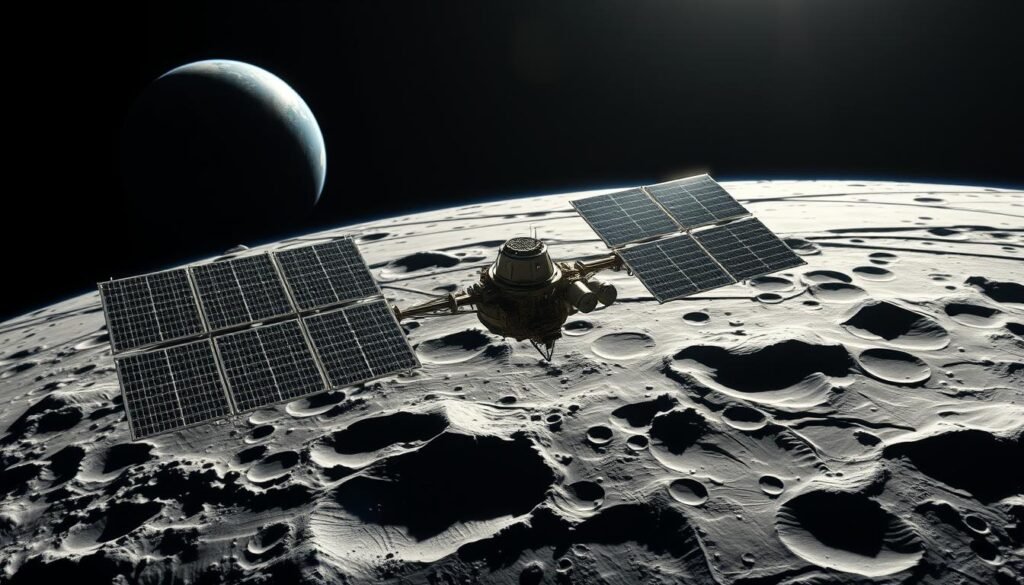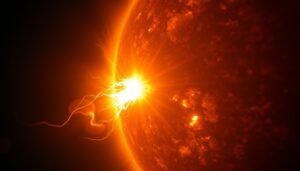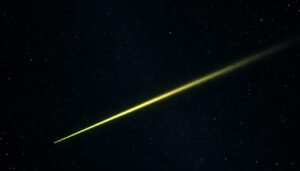NASA Artemis II Mission: Humanity’s Historic Return to the Moon

First Up: Listen to the Sound of a Black Hole ‘Kicked’ Through Space
Creation of an astrophysical holy grail has been announced by scientists after they have succeeded in hearing the sound of a black hole being ‘kicked’ through space. The historical event indeed provides evidence of the theory put forth by famous physicists including Einstein and Hawking.
The discovery of ripples in the space-time fabric sent us on a wild journey to explore mysterious spots, such as black holes and neutron stars. And this event is a case in point, providing the closest look yet at what black holes are like and how they act in space.
Key Takeaways
- Gravitational wave detection has given confirmation of theories by Einstein and Hawking.
- First ‘kick’ of a black hole has been detected – A first: Black hole “kicked” through space.
- This find offers a fresh perspective on the identity of black holes.
- The event constitutes a major milestone for astrophysics.
- The finding has launched fresh expeditions of cosmic exploration.
The Groundbreaking Discovery That Changed Astronomy
Astronomers have achieved a stunning first by hearing the sound of a black hole being propelled through space. This monumental discovery has opened new avenues in understanding cosmic phenomena.
The Moment Scientists Captured the Unprecedented Sound
The capture of the sound was a result of meticulous observation and data analysis. Scientists translated gravitational waves into an audible sound, marking a significant milestone in astronomy.
Key aspects of the discovery include:
- Detection of gravitational waves emitted by the black hole
- Conversion of these waves into sound waves
- Analysis of the sound to understand the black hole’s dynamics
The Research Team and Institutions Behind the Breakthrough
The research team was a collaborative effort involving various institutions and observatories. This teamwork was crucial in achieving the groundbreaking discovery.
Key Scientists and Their Contributions
Several key scientists played pivotal roles in the research. Their contributions included data analysis, theoretical modeling, and experimental design.
Collaborative Efforts Across Observatories
The discovery was made possible by the collaboration across different observatories. This included gravitational wave observatories and other astronomical research facilities.
Understanding Black Holes: Cosmic Enigmas
Understanding black holes is crucial for unraveling the secrets of the cosmos, as they represent some of the most extreme environments in the universe. These mysterious regions of spacetime are characterized by their immense gravitational pull, so strong that not even light can escape once it falls within a certain boundary.
YouTube – Sound of a Black Hole Kicked Through Space
Watch the video explanation
The Fundamental Nature of Black Holes
Black holes are defined by several key properties. Two of the most significant aspects are their event horizons and singularities.
Event Horizons and Singularities
The event horizon marks the boundary beyond which nothing, including light, can escape the gravitational pull of a black hole. Once matter crosses this threshold, it is inevitably pulled towards the singularity, a point of infinite density at the center of the black hole.
Mass, Spin, and Charge Properties
Black holes are characterized by three primary properties: mass, spin, and charge. The mass of a black hole determines its gravitational pull, while its spin can affect the surrounding spacetime. Although black holes are often considered to have no charge, this property can influence their behavior in certain cosmic environments.
How Black Holes Form and Evolve
Black holes form from the collapse of massive stars. When a star exhausts its nuclear fuel, it may collapse under its own gravity, potentially forming a black hole. The evolution of a black hole is influenced by its interactions with the surrounding environment, including the accretion of matter and mergers with other black holes.
Common Misconceptions in Popular Culture
Popular culture often portrays black holes as cosmic vacuum cleaners that indiscriminately suck up everything around them. However, the reality is more nuanced. Black holes only affect matter that crosses their event horizon, and their gravitational influence on distant objects is comparable to that of any other celestial body of the same mass.
Sound of a Black Hole ‘Kicked’ Through Space Heard in a Stunning First
Scientists have successfully translated the gravitational waves emitted by a displaced black hole into sound, marking a historic first in astrophysics. This achievement not only demonstrates the advancements in gravitational wave detection but also offers a novel way to experience cosmic phenomena.
Decoding What the Sound Actually Represents
The sound generated from the gravitational waves of a ‘kicked’ black hole represents the vibrations of spacetime itself. As the black hole moves through space, it creates ripples that are detected and translated into an audible frequency. This process allows us to ‘hear’ the cosmic event in a way that was previously impossible.
The Translation Process: From Gravitational Waves to Audible Sound
The translation of gravitational waves into sound involves a technique known as sonification. By altering the frequency and amplitude of the detected waves, scientists can produce an audible representation of the event.
Sonification Techniques Used
Sonification involves manipulating the data from gravitational wave detections to fit within the human audible range. This process enhances our understanding of the event by providing an auditory dimension to the data.
Frequency and Amplitude Characteristics
The frequency and amplitude of the sound produced are directly related to the characteristics of the gravitational waves. By analyzing these characteristics, researchers can gain insights into the dynamics of the black hole and its environment.
Experiencing the Cosmic Audio: What Listeners Hear
Listeners experience a unique auditory representation of the black hole’s displacement through space. The sound is not a direct recording but rather an interpretation of the gravitational wave data. This auditory representation provides a new perspective on the phenomenon, making it more accessible and engaging for both scientists and the general public.
The Mechanics of a Black Hole ‘Kick’ Phenomenon
Understanding the mechanics behind the ‘kick’ phenomenon in black holes is crucial for advancing our knowledge of cosmic events. The ‘kick’ occurs when two black holes merge, resulting in a gravitational wave emission that can impart a significant recoil velocity to the merged black hole.
Physical Forces That Propel a Black Hole Through Space
The merger of two black holes involves complex astrophysical processes. As these massive objects collide, they release a tremendous amount of energy in the form of gravitational waves. According to Einstein’s theory of general relativity, the asymmetry in the merger process can lead to a net momentum being carried away by the gravitational waves, resulting in a ‘kick’ to the final merged black hole.
“The gravitational wave emission during a black hole merger is not isotropic, leading to a recoil velocity that can be substantial,” said a researcher in the field. This phenomenon highlights the intricate dynamics at play during such cosmic events.
Measuring the Velocity and Trajectory
Measuring the velocity and trajectory of a ‘kicked’ black hole is a challenging task. Astronomers rely on sophisticated simulations and observational data from gravitational wave detectors to infer the properties of the merger and the resulting ‘kick’.
- Gravitational wave observations provide insights into the merger dynamics.
- Simulations help predict the recoil velocity and trajectory of the merged black hole.
- Combining data from multiple observations enhances our understanding of these events.
Why This Event Is So Rare in the Cosmos
The ‘kick’ phenomenon is considered rare due to the specific conditions required for its occurrence. The merger of black holes must be asymmetric to produce a significant ‘kick’.
Probability Factors
Several factors influence the probability of a ‘kick’, including the mass ratio of the merging black holes and their spin configurations. Research suggests that the likelihood of a significant ‘kick’ is higher when the merging black holes have unequal masses or are spinning rapidly.
Conditions Required for a Kick
For a ‘kick’ to occur, the merger must result in a substantial asymmetry in the gravitational wave emission. This requires specific conditions, such as unequal masses or aligned spins, to be met during the merger process.
The study of ‘kick’ phenomena in black holes continues to be an active area of research, with scientists seeking to understand the complex astrophysical processes involved. By exploring these rare cosmic events, we gain valuable insights into the dynamics of black hole mergers and the universe as a whole.
Advanced Technology Behind the Historic Detection
The historic detection of gravitational waves from a black hole was enabled by the latest advancements in gravitational wave observatories. Advanced gravitational wave detection systems have revolutionized the field of astrophysics, allowing scientists to study cosmic events in ways previously impossible.
Gravitational Wave Observatories and Their Capabilities
Gravitational wave observatories like LIGO and Virgo have been instrumental in detecting these cosmic events. These observatories use laser interferometry to measure the minute distortions in space-time caused by gravitational waves.
LIGO, Virgo, and Other Detection Systems
LIGO and Virgo are among the most sensitive gravitational wave detectors, capable of detecting minute changes in distance over vast lengths. Other detection systems are also being developed to enhance our ability to detect gravitational waves.
Sensitivity and Range Limitations
Despite their advanced technology, these detectors have limitations in terms of sensitivity and range. Future upgrades are expected to improve their capabilities, enabling the detection of more distant or weaker gravitational wave sources.
Computational Methods for Data Analysis
The analysis of gravitational wave data requires sophisticated computational methods. These methods involve complex algorithms that can identify the faint signals of gravitational waves within the vast amounts of data collected by the detectors.
The Art and Science of Converting Cosmic Data to Sound
Converting gravitational wave data into sound is both an art and a science. It involves translating the numerical data into an audio format that can be perceived by humans, providing a unique way to experience these cosmic events.
Revolutionary Scientific Implications of the Discovery
The historic detection of a black hole’s sound as it is ‘kicked’ through space is a major milestone in astrophysics, marking a significant scientific breakthrough in our understanding of the universe.
This groundbreaking finding has far-reaching implications, primarily in validating predictions made by Einstein’s theory of general relativity. The observation of the black hole’s motion and the accompanying sound provides strong evidence for the accuracy of these predictions.
Validating Einstein’s General Relativity Predictions
The detection of the black hole’s sound is a crucial validation of Einstein’s general relativity. It confirms that the theory’s predictions about the behavior of massive objects in the universe are correct.
New Understanding of Black Hole Dynamics
The observation has also led to new insights into black hole dynamics. By analyzing the sound and the motion of the black hole, scientists can better understand the forces at play and the behavior of these cosmic phenomena.
How This Changes Our Cosmic Perspective
The discovery changes our understanding of the universe in several ways. Theoretically, it reinforces our understanding of gravity and the behavior of massive objects. Practically, it opens new avenues for research in astrophysics.
Theoretical Implications
Theoretically, this finding supports the predictions of general relativity and enhances our understanding of cosmic phenomena. It also prompts further investigation into the dynamics of black holes and their role in the universe.
Practical Applications in Astrophysics
Practically, the discovery has significant implications for astrophysics research. It encourages the development of new technologies and methodologies to study black holes and other cosmic phenomena.
In conclusion, the detection of the sound of a black hole ‘kicked’ through space is a revolutionary astronomy news that not only validates Einstein’s predictions but also opens new horizons in understanding astrophysical phenomena.
Future Research Horizons Unlocked by This Finding
The historic observation of a black hole ‘kick’ is set to unlock new avenues in space phenomena investigation. This groundbreaking discovery is not only a marvel of modern astronomy research but also a gateway to understanding more complex cosmic events.
Upcoming Targeted Observations
With the successful detection of the black hole ‘kick,’ scientists are now gearing up for upcoming targeted observations. These observations aim to capture more instances of similar phenomena, providing a richer dataset for analysis. By doing so, researchers hope to gain deeper insights into the dynamics of black holes and their role in the universe.
Next-Generation Detection Technology in Development
The detection of the black hole ‘kick’ has also spurred the development of next-generation detection technology. Enhanced gravitational wave detection capabilities are being designed to observe even more distant and complex cosmic events. This technological advancement is crucial for pushing the boundaries of what we know about the universe.
Potential Discoveries on the Horizon
As we venture into this new era of astronomy research, several potential discoveries are on the horizon. These include a better understanding of black hole dynamics and the possibility of observing other extreme cosmic phenomena.
Predicting Similar Phenomena
One of the exciting prospects is the ability to predict similar phenomena. By analyzing the data from the black hole ‘kick,’ scientists can develop models to forecast other instances where such events might occur.
Expanding Our Knowledge of Extreme Physics
Furthermore, this discovery is set to expand our knowledge of extreme physics. The extreme conditions surrounding black holes offer a unique laboratory for understanding the fundamental laws of physics under such extreme conditions.
In conclusion, the detection of the sound of a black hole ‘kicked’ through space has opened up new research horizons. As we move forward with upcoming targeted observations and the development of next-generation detection technology, we can expect significant advancements in our understanding of cosmic events and extreme physics.
The Cosmic Symphony: Other Remarkable Sounds from Space
The cosmos is not silent; it resonates with a variety of sounds that offer insights into celestial phenomena. As we explore these sounds, we gain a deeper understanding of the universe’s complex dynamics.
Pulsar Beats: The Rhythmic Timekeepers of the Universe
Pulsars, or rapidly rotating neutron stars, emit beams of electromagnetic radiation that can be detected as pulses, creating a rhythmic pattern. These “pulsar beats” serve as cosmic timekeepers, helping astronomers study the universe’s structure and evolution.
Planetary and Solar Audio Phenomena
Planetary magnetospheres and solar winds generate a range of audio phenomena, from the eerie sounds of Jupiter’s magnetic field to the solar wind’s constant hiss. These sounds provide valuable information about the solar system’s dynamics.
Comparative Analysis of Different Cosmic Sounds
Comparing the various sounds from space reveals distinct characteristics.
- Frequency patterns vary significantly between pulsar beats and solar audio phenomena.
- The information content in these sounds also differs, offering unique insights into their respective celestial sources.
Frequency Patterns
The frequency patterns of cosmic sounds are determined by their sources. For instance, pulsars have highly regular pulse frequencies, while solar winds produce more chaotic sound patterns.
Information Content in Space Sounds
The information encoded in these sounds is vast, providing data on the physical properties of celestial objects, their environments, and the interstellar medium.
As we continue to explore the universe’s soundscape, we’re reminded of the profound words of astronomer Carl Sagan:
“The universe is a pretty big place. If it’s just us, seems like an awful waste of space.”
The diversity of cosmic sounds underscores the complexity and richness of the universe, inviting us to listen more closely.
Conclusion: Opening Our Ears to the Universe
The groundbreaking detection of the sound of a black hole ‘kicked’ through space heard in a stunning first has revolutionized our understanding of cosmic events. This black hole discovery has far-reaching implications for astronomy research, shedding new light on the dynamics of these enigmatic objects.
As we continue to explore the vast expanse of space, discoveries like this remind us of the awe-inspiring complexity of the universe. The sound, translated from gravitational waves, offers a new perspective on the phenomenon, enriching our knowledge of cosmic events and the universe’s underlying structure.
By advancing our understanding of black holes and the cosmos, this finding paves the way for future space exploration and research into the mysteries of the universe. As we open our ears to the universe, we may uncover even more remarkable secrets hidden within the cosmic symphony.
FAQ










